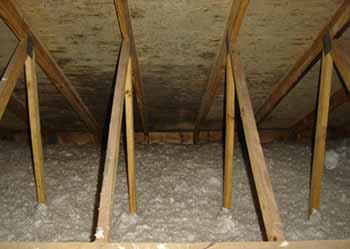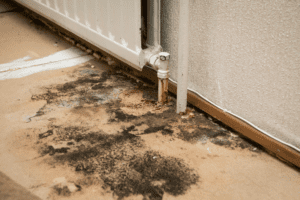Indoor mold growth, whether visible or hidden, can cause a wide variety of problems for humans. If you see or smell signs of mold in your house and you suspect you are having mold related health issues, it’s important to resolve the issue as quickly and safely as possible. Left untreated, indoor mold can cause damage to your home and belongings, and mold exposure has been linked to health issues in humans.
The following conditions stimulate mold growth:
1. Moisture content > 20%
2. Relative humidity > 60%
3. Temperature > 68° F
4. Nutrient or organic material on which to grow (wood, sheetrock, paper, etc.)
With this in mind, always try to keep moisture, humidity and temperature levels low in order to help prevent indoor mold growth. It does not take long for mold to start growing in buildings with the above conditions, especially after a leak, flood, or other “water event.”
Follow Your Nose!
Believe it or not, the most reliable method of finding the source of mold contamination within a building is often right under your nose. When you detect that familiar musty odor / mold smell, it means that mold is actively growing and releasing MVOC’s, or Microbial Volatile Organic Compounds. MVOCs are produced as a metabolic by-product of bacteria and fungi, and are often detectable even before any visible signs of mold growth appear. As a result, our nose can act as an early indicator of a potential mold problem and the odors can lead you directly to the source of contamination. Moldy odors should not be ignored, because even if it is hidden, mold will continue to grow until the issue is resolved.
Visible Mold
Obviously if you have visible signs of mold in your house and mold growth that you can see, then you know where to start your investigation. Even a few specs of mold on the wall can grow into a much bigger problem if ignored. It should be noted that if you discover a major mold problem or have signs of black mold in your home or workplace, you should not disturb the mold, especially if there are individuals with associated health complaints. Carefully investigating with a flashlight is one thing, but removing or disturbing mold spores in a home with an individual having respiratory complications could be dangerous and should be left to a certified mold professional.
Signs of Mold in the Attic
 Attics contaminated with mold can usually be blamed, in part, on the familiar adage “hot air rises.” Signs of mold in the attic are quite common in houses that have neglected proper ventilation protocol. Ideally, the hot air in a building will rise straight to the attic and, when properly ventilated, out into the great outdoors and beyond. But whether by ignorance or to save some time, some builders will actually cover the attic vents with tar paper or insulation. When they do this, the air has nowhere to go! Attic vents are designed to ensure proper air flow and this ventilation is absolutely critical; when vents are blocked, covered, or eliminated, mold and moisture problems result.
Attics contaminated with mold can usually be blamed, in part, on the familiar adage “hot air rises.” Signs of mold in the attic are quite common in houses that have neglected proper ventilation protocol. Ideally, the hot air in a building will rise straight to the attic and, when properly ventilated, out into the great outdoors and beyond. But whether by ignorance or to save some time, some builders will actually cover the attic vents with tar paper or insulation. When they do this, the air has nowhere to go! Attic vents are designed to ensure proper air flow and this ventilation is absolutely critical; when vents are blocked, covered, or eliminated, mold and moisture problems result.
A second common situation observed in attics is when the bathroom or kitchen vents are vented straight into the attic. Releasing these vents into the attic, rather than outdoors, introduces very warm and humid air into an already warm space. Heavily concentrated mold growth is often found right around these vents in attics. If you suspect your mold problem is originating in your attic, check for proper ventilation and you may have your answer.
Signs of Mold in the Basement
Basement mold is a widespread issue. Since basements are built below ground level, and the ground is very moist, moisture in the surrounding soil can  permeate through the foundation. Without preventative measures such as temperature, humidity and moisture management, basement mold will often grow easily.
permeate through the foundation. Without preventative measures such as temperature, humidity and moisture management, basement mold will often grow easily.
There are some precautions you can take to prevent basement mold:
- Thoroughly inspect walls, floors & ceiling for obvious cracks, holes, drainage problems or signs of moisture.
- Immediately repair any problems found
- Apply a good quality waterproof sealant to the floors and walls.
- Invest in a dehumidifier and/or air conditioner to maintain proper humidity levels (must be kept below 60% relative humidity)
- Invest in a hygrometer so you can check humidity levels often.
- There are contractors that specialize in “Basement Waterproofing”; certainly a more expensive way to go but a good option if you can afford it.
Signs of Mold in the Bathroom
 Bathrooms are another common area where mold is often found. Causes of bathroom mold problems include:
Bathrooms are another common area where mold is often found. Causes of bathroom mold problems include:
- Long, hot showers
- Soaking baths
- Running water at the sink
- Condensation on mirrors / windows
- Countertop spills
- Tub & sink splashing
- Standing water left to sit
- Bathroom fan not venting outside
- Not using the bathroom fan at all
Here are some tips to help prevent bathroom mold:
- Install a fan that vents outside, and make sure to use it!
- Crack a window
- Wipe up all visible water & moisture with each bathroom visit.
Water Events, Standing Water, Flooding & Mold
 If you have signs of mold in your main living space, and you are sure that the problem is not originating in your attic or basement, then there must be some sort of moisture issue in the main living area. This issue may be known to you (an overflowing tub for example) or unknown (a leaking pipe in the wall cavity). These moisture issues are all called “water events,” and resolving them is the key to stopping a major mold problem.
If you have signs of mold in your main living space, and you are sure that the problem is not originating in your attic or basement, then there must be some sort of moisture issue in the main living area. This issue may be known to you (an overflowing tub for example) or unknown (a leaking pipe in the wall cavity). These moisture issues are all called “water events,” and resolving them is the key to stopping a major mold problem.
The first thing to do is to check all of your appliances, plumbing and pipes, and look for all possible sources of leaks or moisture problems. Look for water stains and visible mold growth on all walls and floors. Also think about recent episodes of water invading your living area (overflowing sinks, water heaters, flooding, etc.). Many times people don’t know they have a problem with mold until they start to smell it. Other times the problem is much more obvious, like when you notice “black stuff” growing on your wall. Either way, appropriately removing the mold along with correcting the water intrusion or water source is your key to being mold free.
When you find mold in your home or business
For major mold infestations, we recommend you call a board-certified Indoor Air Quality professional. But if your mold problem seems minor (a small confined patch of mold with no associated odors or health issues), check out our Mold Prevention Checklist for some tips and tricks.

